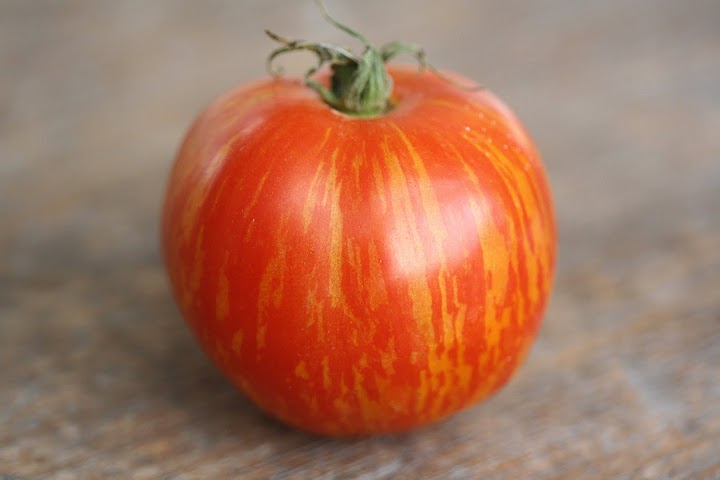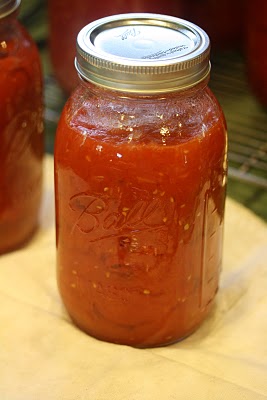
Until last month, I was under the impression that canning was an art best left to the experts. I don't mean only the Sarabeths and the San Marzanos, but also to the Mrs. Wheelbarrows and the Hip Girls. It was the kind of thing that just seemed up too many notches from the place where I normally cook, the type of experiment that just wouldn't be feasible with my limited resources and infintesmal counter space.
In truth, this is not really a small kitchen activity, though naysayers may beg to differ. I can see that if you were really experienced and really confident, you might not need the oodles of space that my mom and I and our inefficient canning process required.
A long time ago, my mom and I planned that we'd spend the Sunday after Yom Kippur canning Long Island tomatoes for the winter. I put it on my calendar in about July, but I wondered if we'd go through with it. I won't lie: I was really intimidated. Then Mrs Wheelbarrow's interview went up on NPR's site and everyone I'd ever spoken to seemed to forward it by email to me. Mom and I were invigorated, and we started planning in earnest.
Who, in the end, would not want to preserve such a summer beauty for the cold season?
Honestly, Mom did a vast majority of said planning, including owning a kitchen with enough counter space for us to work as un-ergodynamically as beginning canners, I suppose, must. She also bought 25 pounds of Roma tomatoes from a farmstand we like, plus four 5-pound bags of peaches, for peach salsa. She ordered beautiful jars, a large pot for sealing the cans, and a canning accessory pack which turned out to include the day's MVP--a magnetic lid-lifter wand. From the depths of our house's bookshelves, she pulled Back to Basics, whose tips helped answer any questions we still had--about canning and, naturally, about log cabin building.
We started with the tomatoes. We washed all of them in one sink, then transported them to the side of the stove. There, we plunged each into boiling water for less than a minute, scooped them out, and transported them to the other side of the kitchen, where, in sink #2, an ice bath was waiting. This continued for a while. As the sink filled up with blanched Roma tomatoes, we started to core and peel them. We squeezed the peeled tomatoes between our fingers, letting a lot of the seeds be discarded in a garbage bowl (yes, Rachael Ray). The smushed tomatoes were starting to look a whole lot like the tomatoes inside a Muir Glen can. Peeling, coring, and smushing must have taken at least an hour, but it was an hour that went by quickly.
Next step? Cooking the tomatoes for a cool five minutes in the largest stockpot in the house, the one we use for soup for twenty-five people on Thanksgiving.
Up til now, nothing had really been intimidating except the vast amounts. But now we had to can. The ghost of botulism visited us in the kitchen, and all the horror stories about lids not sticking on cans suddenly came to mind. It wasn't as bad as I thought it would be, but it was a little hectic. We'd sterilized the wrong can lids (in a startling realization, we saw that the small lids did not fit the small cans--it was vice versa), and we couldn't quite get a rhythm down. As I said, the little magnet magic wand, which lifted lids straight from the boiling water and placed them, no dirty fingers necessary, atop each can, was truly the MVP of the day. We screwed on the second part of the lid and dropped each can into the canning pot, filled with boiling water and fitted with a can-holding basket. There, the cans boiled away for forty-five minutes.
When I lifted them out and set them on racks and on towels, they started to pop. We weren't sure if they'd all popped or if popping was even a good thing. I tweeted @MrsWheelbarrow, asking, and she reassured me.
We were much more confident moving onto the peaches, even though there was definitely more prepwork with those due to their having pits that need to be cut out. I left Mom to that while I got onions, pepper, cilantro et al ready for the peach salsa.
The second time through was smooth, compared to the first. We got a real assembly line going, both with the prep and with the actual canning. By about 4:30, we had a dozen cans of peach salsa and eight of tomatoes for the winter.
So, I feel inducted. Into a world where slowing down is necessary, and the reward is both a can of local tomatoes and a day spent in the kitchen with my mom. Next September, you'll definitely find us canning again.
--Cara Eisenpress of Big Girls, Small Kitchen
Crushed Tomatoes
Ingredients
25 pounds of tomatoes
Bottled lemon juice
Kosher salt
Sterilized jars, lids and rings
Dip the tomatoes in boiling water for 30-60 seconds, then plunge into a large bowl filled with ice water. (I use my sink or a cooler.)
Once all the tomatoes have been blanched, begin peeling and crushing them. Cut out the core and any soft spots, then cut an X in the base of the tomato and slip off the peel.
Squeeze the tomato in your hands, releasing the juice and most of the seeds, then either chop further, or just place the crushed pulp in a deep nonreactive stockpot. Continue to peel and crush until all the tomatoes are in the stockpot.
Bring the tomatoes to a hard boil and boil well for 5 minutes.
Put 2 tablespoons lemon juice and 1 teaspoon salt in each quart jar. (Use 1 tablespoon lemon juice and 1/2 teaspoon salt for each pint.)
Fill the jar, leaving half an inch of head space. Wipe the rims, place the lid and ring, and finger tighten.
Process in a boiling water bath for 45 minutes (quarts) or 40 minutes (pints.)
Turn off the stove, allow the jars to rest in the boiling water for 5 minutes, then remove them to the counter, where they should remain, undisturbed, for 24 hours.
After a day, test the seals, wipe the jars clean, and store in a cool, dry place for up to one year.
Makes 6-7 quarts of tomatoes.

